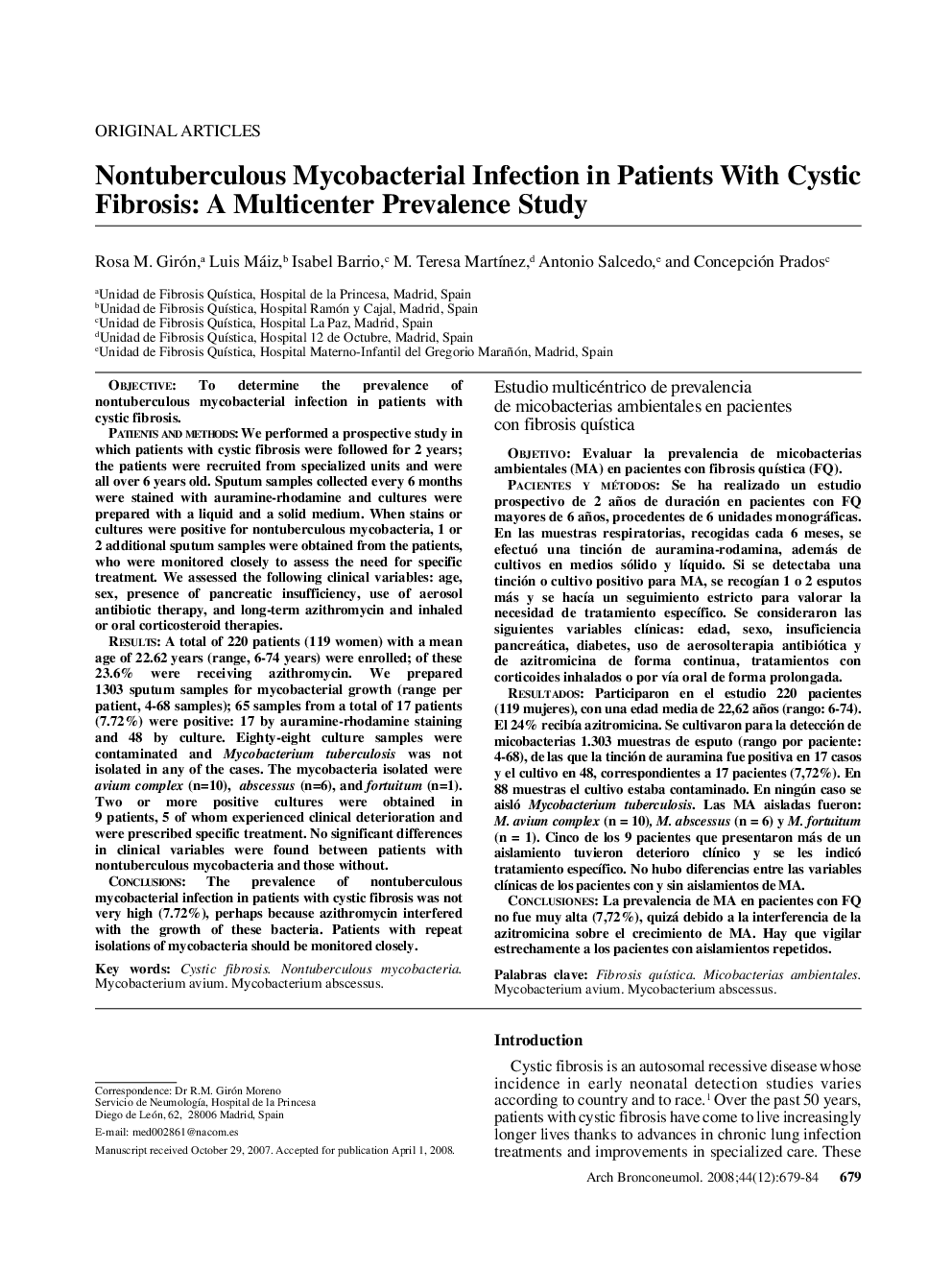| Article ID | Journal | Published Year | Pages | File Type |
|---|---|---|---|---|
| 4206190 | Archivos de Bronconeumología (English Edition) | 2008 | 6 Pages |
ObjectiveTo determine the prevalence of nontuberculous mycobacterial infection in patients with cystic fibrosis.Patients and methodsWe performed a prospective study in which patients with cystic fibrosis were followed for 2 years; the patients were recruited from specialized units and were all over 6 years old. Sputum samples collected every 6 months were stained with auramine-rhodamine and cultures were prepared with a liquid and a solid medium. When stains or cultures were positive for nontuberculous mycobacteria, 1 or 2 additional sputum samples were obtained from the patients, who were monitored closely to assess the need for specific treatment. We assessed the following clinical variables: age, sex, presence of pancreatic insufficiency, use of aerosol antibiotic therapy, and long-term azithromycin and inhaled or oral corticosteroid therapies.ResultsA total of 220 patients (119 women) with a mean age of 22.62 years (range, 6-74 years) were enrolled; of these23.6% were receiving azithromycin. We prepared 1303 sputum samples for mycobacterial growth (range per patient, 4-68 samples); 65 samples from a total of 17 patients(7.72%) were positive: 17 by auramine-rhodamine staining and 48 by culture. Eighty-eight culture samples were contaminated and Mycobacterium tuberculosis was not isolated in any of the cases. The mycobacteria isolated were avium complex (n=10), abscessus (n=6), and fortuitum (n=1). Two or more positive cultures were obtained in 9 patients, 5 of whom experienced clinical deterioration and were prescribed specific treatment. No significant differences in clinical variables were found between patients with nontuberculous mycobacteria and those without.ConclusionsThe prevalence of nontuberculous mycobacterial infection in patients with cystic fibrosis was not very high (7.72%), perhaps because azithromycin interfered with the growth of these bacteria. Patients with repeat isolations of mycobacteria should be monitored closely.
ObjetivoEvaluar la prevalencia de micobacterias ambientales (MA) en pacientes con fibrosis quística (FQ).Pacientes y métodosSe ha realizado un estudio prospectivo de 2 años de duración en pacientes con FQ mayores de 6 años, procedentes de 6 unidades monográficas. En las muestras respiratorias, recogidas cada 6 meses, se efectuó una tinción de auramina-rodamina, además de cultivos en medios sólido y líquido. Si se detectaba una tinción o cultivo positivo para MA, se recogían 1 o 2 esputos más y se hacía un seguimiento estricto para valorar la necesidad de tratamiento específico. Se consideraron las siguientes variables clínicas: edad, sexo, insuficiencia pancreática, diabetes, uso de aerosolterapia antibiótica y de azitromicina de forma continua, tratamientos con corticoides inhalados o por vía oral de forma prolongada.ResultadosParticiparon en el estudio 220 pacientes (119 mujeres), con una edad media de 22,62 años (rango: 6-74). El 24% recibía azitromicina. Se cultivaron para la detección de micobacterias 1.303 muestras de esputo (rango por paciente: 4-68), de las que la tinción de auramina fue positiva en 17 casos y el cultivo en 48, correspondientes a 17 pacientes (7,72%). En 88 muestras el cultivo estaba contaminado. En ningún caso se aisló Mycobacterium tuberculosis. Las MA aisladas fueron: M. avium complex (n = 10), M. abscessus (n = 6) y M. fortuitum (n = 1). Cinco de los 9 pacientes que presentaron más de un aislamiento tuvieron deterioro clínico y se les indicó tratamiento específico. No hubo diferencias entre las variables clínicas de los pacientes con y sin aislamientos de MA.ConclusionesLa prevalencia de MA en pacientes con FQ no fue muy alta (7,72%), quizá debido a la interferencia de la azitromicina sobre el crecimiento de MA. Hay que vigilar estrechamente a los pacientes con aislamientos repetidos.
